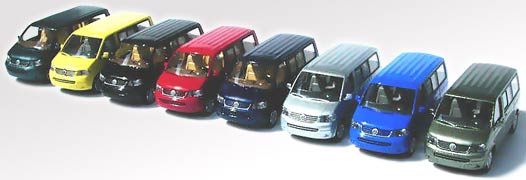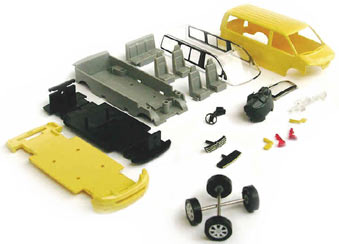2003 Volkswagen Multivan by Wiking
Please note: The opinions expressed in our reviews are the views of the reviewer and do not necessarily reflect the views and opinions of the 1/87 Vehicle Club. |

Wiking's Lineup of Volkswagen Multivan Promotional
Models
Ever since I first saw Wiking’s all-new Multivan model on February 2 at the Nuremberg Toy Fair, I wanted to write a review. Now that the promotional versions have been sitting on my desk for a couple of weeks and I finally found the time to write these lines, I face the same problem as Jeff Webster recently did with his Athearn Ford “C” fire truck – to expand the review from “Awesome.” Forgive me for starting with the conclusion, but this is one impressive scale car! The Prototype Beginning with the introduction of the 1996 Passat, Volkswagen went upmarket; aiming at Mercedes-Benz rather than their “natural” mass-market competitors, Opel and Ford. Premium was the word of the decade. (With a similar idea in mind, Ford grouped their upscale brands in the London-based Premier Automotive Group, PAG.) Meant to help Volkswagen’s new approach was the visibly and emphatically enhanced quality, which showed in the reduced gaps between the sheet metal, the expensive-looking interior plastics, and neat touches such as BMW-style air vents. The Passat was a whole class above its predecessor, even more so in the enhanced 2000 version, and not just in VW’s perception. The 1997 Golf IV wore the same aura, as did, to a lesser degree, the 2001 Polo. All these cars were necessary to prepare the public for the 2002 Phaeton luxury car and the 2002 Touareg SUV. The Phaeton even got its dedicated assembly site in the heart of Dresden, the so-called “Transparent Manufactory,” where buyers can follow the final assembly of their car in a building that looks more like a luxury hotel than a mere production site. Without the previous models’ upgrades, it would have been almost impossible to sell a € 100,000 car with the Volkswagen logo, which means “car for the people,” after all. With this approach, it was only natural for Volkswagen to position the passenger versions of their fifth-generation Transporter next to the Phaeton and Touareg. Consequently, they do not refer to the new people-carrier as the T5, but only as the Multivan, clearly separating it from the worldlier commercial versions bearing the Transporter name. Perhaps Volkswagen’s marketing is better than Mercedes’, where customers quickly recognized a truck when they saw one – the current V-Classes are nothing but upgraded Vito vans, and they show in every detail. To underline the Multivan’s position, it is available with the narrow-angled 230hp 3.2-liter V6 known from Golf RS, Phaeton and Touareg as well as with a new 2.5-liter inline-five diesel producing 174hp. Both engines are linked to manual or automatic six-speed transmissions. The diesel is reported to be the Touaregs’s 313hp V10 TDI cut in half. On the lower end of the range, there are 104hp (inline-four) and 130 hp (inline-five) TDIs and the well-known 115hp 2.0-liter gasoline inline-four. The comparison to the previous T4 – sorry: Multivan (Eurovan in the U.S.) – does not reveal too many differences. Dimensions grew modestly, measuring now 192.5 by 75.0 by 77.1 inches (length/width without mirrors/height) on a wheelbase of 118.1 inches. The exterior lines differ only marginally, but they are more in line with Volkswagen’s upscale approach now: reduced gaps, clear-glass headlamps, solid door-handles, hidden sliding-door carriages and all the other nifty details Volkswagen learned to apply.
The Scale Model As debatable as putting the Multivan side to side with Phaetons and Touaregs may be in the world of prototypes, as evident this comparison is when the Wiking models come into focus. Earlier VW promotionals such as the New Beetle and the Polo were nice models, but the Phaeton marked the departure to a whole new level. Individually fitted rear-view mirrors were a first for Wiking, and about as striking was the amount of detail printing and chrome stripes (painted in silver, to be honest). These were hardly new features, as Busch and especially Herpa had offered them earlier, but in combination with Wiking’s excellent paint job, they truly made for a first-class model. The Touareg went slightly further with its finely printed model name and engine markings on the rear hatch, mirrors that would stand taking the model out of a display case (or out of its box, as it were), and the side windows’ improved fit, just to name a few. The overall impression was just stunning – as perfect as a 1/87th scale model currently gets.
The new Multivan is all that, and more. The 28 parts fit together without gluing, quite a rarity for a Wiking model and something for which modelers will be thankful. (Not too thankful, perhaps as disassembling the model means a good chance to break one of the finest plastic vehicles on the market. It is strongly recommended to start with the taillights and the front side air intakes – note the plural! Afterwards, the model will more or less fall apart.) The front and rear bumpers are molded as one piece and they allow for being colored different from the body, which will come in handy for the Transporter. The interior is as cleverly designed and will also fit the commercial versions later: The rows of seats remove easily and show the perfect cargo bed. Speaking of the seats, the second-row passengers may also face the third-row occupants after the center-row is turned. The next step probably is a vertically and horizontally adjustable steering column. The dashboard already features all the details that make sense in such a small scale, among these the joystick-like gearlever on the center-console. The dimensions appear to be perfect to scale. Only the wheels, which represent the Comfortline version’s 16” alloys, measure a scale inch too large. However, larger wheels usually benefit a model’s overall appearance, which is certainly true in this case. After the promotional models mentioned above, the “Multivan TDI” printing on the model’s rear is not a surprise anymore. Striking, though, are the two front side air intakes which bear a (silver, again) chrome stripe and additional body-colored detail prints to match the prototype’s parts. The paint job is very well done, and as before, each and every color will be painted, be it metallic or standard finish, the former with additional clear coating. Downsides? There are a few, but they are of the rivet-counting kind and may be cured by an unskilled modeler. The windshield wipers will need to be painted flat black and the rearview mirrors won’t mind a bit of silver paint. After the Touran MPV delighted us with the silver-painted indicator section within the taillights, this feature is omitted from the Multivan. More of a concern, in this context, is the lack of a freestanding interior mirror – but it is a concern only because Herpa and Busch demonstrated that this is feasible. Is it necessary? Probably not. The only true deficit appears to be the lack of headrests on the third-row seats. With gray interiors, even this – admittedly very small – fault is almost invisible. The Verdict What shall I say? If you have read the above, you will know how lovely Wiking’s T5 is. In comparison to Herpa, it must be noted the special features such as silver-painted wheels and all the detail printing will survive once the model goes into regular distribution. However, the price was subject to spirited discussions among collectors as it is more than 50% above the Phaeton’s at Volkswagen. It may be assumed, though, that Wiking’s suggested retail price remains the same as for previous VWs at 9.50 € or US $14.00. One question remains: At this time, there are eight colors reserved by Volkswagen. Are there enough customers to buy a regular version after Volkswagen offered such a huge number of models? I hope there will be because the model is worth it! Important note: Currently neither the 1:1 or 1:87 scale Multivans are available in the U.S. It is anticipated that the real Multivan will make it to the U.S. in 2004 or 2005. We'd expect the Wiking Multivan model to be in distribution by then. For now, you need a friend in Germany! Marc Schmidt |


